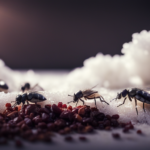The saying, ‘An ounce of prevention is worth a pound of cure,’ perfectly captures the strategy for dealing with small spiders in your home. Even though they may be small, these arachnids can quickly become a nuisance if not dealt with promptly.
In this article, I will guide you through the process of getting rid of these tiny spiders and preventing future infestations.
First and foremost, it is important to identify the type of spider present in your house. This knowledge will help you determine the best course of action.
Once you have identified the spider, it’s time to roll up your sleeves and get to work. Keeping your house clean and clutter-free is essential, as it eliminates potential hiding spots for spiders. Sealing entry points, removing spider webs and egg sacs, and using natural repellents are all effective methods to keep these critters at bay.
If these DIY methods don’t yield the desired results, consider using spider sprays or insecticides. However, be sure to follow the instructions carefully and take necessary precautions. Additionally, maintaining cleanliness in outdoor areas is crucial, as spiders often find their way inside from there.
In some cases, professional pest control may be needed to tackle a severe infestation. Don’t hesitate to seek help if necessary. Lastly, implementing preventive measures such as regular cleaning, sealing cracks, and using spider repellents can help prevent future infestations.
By following these steps, you can reclaim your home from those pesky tiny spiders and create a spider-free environment for you and your family.
Key Takeaways
- Identify the type of spider present in your house to determine the best course of action.
- Keep your house clean and clutter-free to eliminate potential hiding spots for spiders.
- Seal entry points, remove spider webs and egg sacs, and use natural repellents to keep spiders at bay.
- If DIY methods don’t work, consider using spider sprays or insecticides, but take precautions.
Identify the Type of Spider Present
Now that you’re on the hunt for those tiny spiders in your house, let’s figure out what type of spider you’re dealing with!
Spiders come in various shapes, sizes, and colors, and identifying them is crucial for effective pest control. Start by observing their physical characteristics. Look at the number of eyes, the arrangement of their legs, and the presence or absence of certain markings. This will help you determine the spider’s family or genus.
Next, pay attention to their behavior patterns. Some spiders build intricate webs to catch prey, while others actively hunt and pounce on their victims. Understanding their behavior will give you insight into where they might be hiding in your home.
Additionally, consider the geographical location and habitat preferences of the spider species you’ve identified. Armed with this knowledge, you can tailor your approach to eliminate them effectively.
Now that we know what type of spider we’re dealing with, let’s move on to the next step of keeping your house clean and clutter-free.
Keep Your House Clean and Clutter-Free
To prevent spiders from taking up residence in your home, it’s crucial to maintain a clean and clutter-free environment. Regularly vacuum your floors and carpets to remove dust, debris, spider webs, and eggs. Additionally, frequently dust and sweep to eliminate potential hiding spots for spiders. Lastly, declutter your home to reduce hiding places for spiders, making it easier to spot and eliminate them.
By following these simple steps, you can create an inhospitable environment for spiders and keep your home spider-free.
Vacuum Regularly
Make sure you’re vacuuming regularly to tackle those pesky little spiders in your house. Not only will vacuuming help remove spider webs and eggs, but it’ll also eliminate any other insects that may be attracting spiders to your home.
When vacuuming, pay special attention to corners, baseboards, and other hidden areas where spiders like to hide. It’s important to identify the spider species in your house, as some may require specific control methods. Natural spider control methods such as using essential oils or vinegar can be effective in repelling spiders.
Additionally, keeping your house clean and clutter-free will make it less attractive to spiders. Dust and sweep frequently to remove any spider webs or hiding places.
By following these steps, you can create a spider-free environment in your home.
Dust and Sweep Frequently
Regularly dusting and sweeping your home is like a gentle breeze that keeps the cobwebs and dirt at bay, creating an environment where spiders find no solace. To effectively eliminate tiny spiders, it’s crucial to implement organizing strategies and pest control methods. Here are three key ways to tackle these pesky arachnids:
-
Declutter: Spiders thrive in cluttered spaces, so it’s important to keep your house tidy and organized. Remove unnecessary items and create a streamlined living environment.
-
Clean corners and ceilings: Spiders often build their webs in hard-to-reach areas. Regularly dust and sweep these spots to eliminate any existing webs and discourage spiders from returning.
-
Use natural deterrents: Consider using natural spider repellents such as peppermint oil, vinegar, or citrus-scented cleaners. These scents are known to repel spiders and can be easily incorporated into your cleaning routine.
By incorporating these organizing strategies and pest control methods, you can create a spider-free home environment.
Next, let’s explore how decluttering your home can further enhance spider prevention efforts.
Declutter Your Home
Keep your living space clean and organized, and you’ll create an inviting environment that spiders won’t want to steer clear of. Clutter provides hiding spots for spiders, so it’s important to declutter your home to prevent spider infestations.
Start by getting rid of unnecessary items and organizing belongings in storage containers. Pay special attention to areas that are prone to clutter, such as basements, attics, and closets. Regularly go through your belongings and donate or discard items you no longer need.
Additionally, keep your floors clear of debris and vacuum regularly to remove any spider webs and eggs. By creating a clutter-free environment, you’re minimizing hiding spots for spiders and reducing the likelihood of an infestation.
This will transition into the subsequent section about ‘seal entry points’ where we’ll explore how to prevent spiders from entering your home.
Seal Entry Points
To prevent those pesky tiny spiders from invading your home, it’s essential to seal up any entry points you find. By sealing gaps and blocking entryways, you can ensure that spiders have no way of sneaking into your house. Here are four effective ways to seal entry points and keep those spiders at bay:
-
Inspect windows and doors: Check for any cracks or gaps around windows and doors. Apply weatherstripping or caulk to seal these openings.
-
Fill gaps in walls: Look for any small holes or gaps in your walls, especially near pipes and cables. Use a sealant or putty to fill these gaps.
-
Seal vents and chimneys: Install mesh screens over vents and cover chimneys with a mesh cap to prevent spiders from entering through these openings.
-
Repair damaged screens: Inspect your window and door screens for any tears or holes. Replace or repair them to keep spiders from crawling in.
Sealing entry points is a crucial step in spider control, as it eliminates their access to your home. Once you’ve successfully sealed these openings, you can proceed to the next section: removing spider webs and egg sacs.
Remove Spider Webs and Egg Sacs
Once you’ve sealed up any entry points, how can you safely eliminate spider webs and egg sacs from your home? Removing spider webs and egg sacs is an essential step in getting rid of tiny spiders in your house and preventing future infestations. It is important to approach this task with caution and use preventive measures to ensure your safety. To help you with this process, I have created a table below outlining some effective methods for removing spider webs and egg sacs.
| Method | Description |
|---|---|
| Vacuuming | Use a vacuum cleaner with a brush attachment to carefully remove the webs |
| Duct Tape | Wrap duct tape around your hand, sticky side out, and gently touch the webs |
| Feather Duster | Gently brush away the webs and egg sacs using a soft feather duster |
Remember to wear gloves and a mask when handling spider webs and egg sacs to protect yourself from potential allergens and bites. After removing the webs, it is important to dispose of them properly. Now that you have eliminated the spider webs and egg sacs, let’s explore natural alternatives to repel spiders without harming them.
Use Natural Spider Repellents
When it comes to repelling spiders naturally, there are three key points to consider: essential oils, vinegar, and chestnuts.
Essential oils such as peppermint and lavender have been found to be effective at repelling spiders due to their strong scent.
Vinegar, when sprayed around windows, doorways, and other entry points, can create a barrier that spiders are reluctant to cross.
Lastly, chestnuts, when placed strategically around the house, can act as a natural deterrent for spiders, as they dislike the smell.
Essential Oils
Using essential oils, you can easily banish those tiny spiders from your house. Natural remedies like essential oils are a great DIY solution for spider control. Here are three essential oils that can effectively repel spiders:
-
Peppermint Oil: Spiders despise the strong scent of peppermint oil. Dilute a few drops of peppermint oil with water and spray it around windows, doors, and other areas where spiders are commonly found.
-
Tea Tree Oil: Tea tree oil has powerful antifungal and antibacterial properties, making it an effective spider repellent. Mix a few drops of tea tree oil with water and wipe down surfaces to deter spiders.
-
Lavender Oil: Known for its calming scent, lavender oil can also keep spiders at bay. Place a few drops of lavender oil on cotton balls and strategically place them around your house.
By using these essential oils, you can naturally repel spiders and create a spider-free environment.
In the next section, we’ll explore the benefits of using vinegar as a spider repellent.
Vinegar
To keep those eight-legged intruders at bay, vinegar can be your secret weapon. Picture this: imagine your home as a fortress, with vinegar acting as the impenetrable moat, repelling spiders and keeping them far away from your sanctuary.
Vinegar, a versatile household ingredient, has numerous uses and benefits when it comes to getting rid of tiny spiders in your house. Its strong smell and acidic properties make it a potent deterrent for these creepy crawlies. Simply mix equal parts of vinegar and water in a spray bottle and target areas where spiders are likely to hide or enter your home. Spray corners, windowsills, and crevices to create a spider-repellent barrier. The acetic acid in vinegar disrupts their sensory receptors, making your house a place they’ll want to avoid.
Now, let’s move on to the next natural remedy: chestnuts.
Chestnuts
Chestnuts, with their natural properties, offer a comforting and effective solution for keeping those unwanted arachnids away from your peaceful home. Not only are chestnuts a tasty addition to many recipes, but they also possess a scent that spiders find repulsive. This scent acts as a deterrent, making your home less inviting to these tiny creatures.
However, it’s important to note that some individuals may have chestnut allergies, which can cause symptoms such as itching, hives, or even difficulty breathing. If you or anyone in your household experiences these symptoms, it’s best to avoid using chestnuts as a spider repellent.
Now, let’s move on to the next section where we’ll explore the use of spider traps to further combat these pesky intruders.
Use Spider Traps
Spider traps are a convenient and effective way to eliminate those pesky little spiders from your house. They’re a top choice when it comes to spider repellent alternatives and natural spider control methods. These traps work by luring spiders in and trapping them, preventing them from roaming freely in your home.
Spider traps typically consist of a sticky adhesive surface that spiders get trapped on when they walk over it. They’re easy to use and require minimal effort on your part. Simply place the traps in areas where you have noticed spider activity, such as corners, windowsills, or basements. The sticky surface will attract the spiders and prevent them from escaping.
One advantage of using spider traps is that they’re non-toxic and safe to use around pets and children. Unlike chemical sprays or insecticides, spider traps don’t release any harmful fumes or chemicals into the air. They’re also a discreet method of spider control, as the traps can be placed out of sight.
Spider traps are an effective and safe way to get rid of tiny spiders in your house. However, if you’re dealing with a severe infestation or want a more comprehensive approach, you may want to consider using spider sprays or insecticides. These products can provide additional control and help eliminate spiders from your home more quickly.
Use Spider Sprays or Insecticides
Try using spider sprays or insecticides to effectively eliminate those pesky critters from your home and enjoy a spider-free living space. Spider sprays and insecticides are popular spider repellent alternatives that can help you control spider infestations. These products typically contain chemical compounds that are toxic to spiders, effectively killing them upon contact. When choosing a spider spray or insecticide, it’s important to consider the safety of your family and pets.
Look for products that are labeled as safe for indoor use and follow the instructions carefully.
There are also natural spider control methods available if you prefer to avoid using chemical products. Essential oils such as peppermint, lavender, and tea tree oil have been found to be effective spider repellents. Simply mix a few drops of your chosen oil with water in a spray bottle and apply it to areas where spiders are commonly found.
Additionally, keeping your outdoor areas clean and free from debris can help prevent spiders from entering your home. Regularly sweep away spider webs, remove clutter, and trim plants near your house to reduce spider habitats.
By using spider sprays or insecticides, or opting for natural spider control methods, you can effectively get rid of tiny spiders in your house. Keeping outdoor areas clean is another important step in maintaining a spider-free living space.
Keep Outdoor Areas Clean
When it comes to keeping outdoor areas clean, there are a few key points to consider. First, trimming trees and bushes regularly can help prevent spiders from making their homes in these areas.
Removing debris and clutter from the yard also eliminates potential hiding spots for spiders.
Lastly, using outdoor insecticides can provide an extra layer of protection against spiders and other pests.
By following these steps, you can maintain a clean and spider-free outdoor environment.
Trim Trees and Bushes
By pruning overgrown trees and bushes, you can create a more open and airy environment in your yard, making it less appealing for those pesky little spiders to spin their webs in your house. Pruning techniques involve cutting back branches and foliage to maintain the desired shape and size of the plants. This not only enhances the aesthetics of your outdoor space but also reduces hiding spots for spiders.
Additionally, by trimming trees and bushes, you can prevent them from touching or overhanging your house, further discouraging spiders from entering. Natural deterrents such as planting mint, lavender, or eucalyptus around your yard can also help repel spiders. These plants release scents that spiders dislike, making them less likely to settle near your home.
Removing debris and clutter from your yard will be the next step to create an environment that spiders find unattractive.
Remove Debris and Clutter
To effectively address the issue of tiny spiders in your house, it’s essential to take a comprehensive approach. In addition to trimming trees and bushes, another crucial step is to remove debris and clutter from your surroundings.
This not only eliminates potential hiding spots for spiders but also creates a cleaner and more organized living space. Decluttering benefits extend beyond spider control, as it reduces dust accumulation and improves overall indoor air quality.
To get started, focus on sorting and organizing items, discarding unnecessary belongings, and finding designated storage areas for remaining items. Implementing simple organizing tips, such as using storage bins or shelves, can go a long way in maintaining a clutter-free environment.
By following these steps, you can create a more spider-resistant home.
Now, let’s move on to the next section and explore the use of outdoor insecticides in further detail.
Use Outdoor Insecticides
For a more effective approach in dealing with those pesky little spiders in your home, it’s time to consider using outdoor insecticides. These powerful formulations are specifically designed to target and eliminate spiders, ensuring a spider-free environment.
When using outdoor insecticides, it’s important to prioritize safety. Follow the instructions carefully, wearing protective clothing and gloves to minimize any potential risks. Additionally, consider alternative spider control methods that are environmentally friendly and less toxic.
For example, you can try using natural repellents like peppermint oil or vinegar, or employ mechanical methods such as vacuuming and sealing cracks. By combining these approaches, you can significantly reduce the spider population in your house.
However, if the infestation persists or worsens, it may be time to consider professional pest control for a more thorough and long-lasting solution.
Consider Professional Pest Control
Hiring a professional pest control service can be a highly effective solution for addressing the issue of tiny spiders in your house. While there are various DIY solutions and natural spider deterrents that you can consider, sometimes these methods may not provide the desired results.
This is where the expertise of a professional pest control service comes in handy. Professional pest control companies have the knowledge and experience to accurately identify the type of spiders infesting your home and determine the most effective treatment plan. They have access to a wide range of insecticides and can use them in a targeted manner to eliminate the spiders without causing harm to your family or pets.
Moreover, professional pest control services also offer long-term solutions to prevent future infestations. They can identify and seal off potential entry points for spiders, such as cracks and gaps in walls, windows, and doors. They may also provide recommendations on how to make your home less attractive to spiders, such as reducing clutter and removing food sources.
By hiring a professional pest control service, you can ensure that your house is spider-free and take preventive measures to avoid future infestations. So, if you’re dealing with tiny spiders in your house, it might be worth considering professional help for a more comprehensive and lasting solution.
Prevent Future Infestations
To prevent future infestations of tiny spiders in the house, it’s important to prioritize regular maintenance and cleaning. This includes keeping the house clutter-free, vacuuming regularly, and sealing any cracks or openings where spiders can enter.
Additionally, scheduling regular pest control inspections can help identify and address any potential spider infestations before they become a problem.
Lastly, educating yourself on spider prevention techniques, such as understanding their habits and habitats, can empower you to take proactive measures to keep your home spider-free.
Regular Maintenance and Cleaning
Regularly cleaning and maintaining your home can keep those pesky little spiders from making themselves too comfortable. To effectively clean, start with vacuuming the floors, corners, and crevices where spiders tend to hide. Be sure to use a vacuum with a HEPA filter to trap any spider eggs or webs.
Dusting regularly is also crucial, as spiders prefer dusty areas. Use a microfiber cloth or a duster to reach high and low spots, including ceilings, window sills, and baseboards. Don’t forget to declutter and organize your belongings, as spiders love to hide in cluttered areas.
Additionally, consider sealing any cracks or gaps in windows, doors, and walls to prevent spiders from entering your home. By consistently practicing regular maintenance and cleaning, you can create an environment that’s less inviting to spiders.
Transitioning into regular pest control inspections allows for a comprehensive approach in keeping your home spider-free.
Regular Pest Control Inspections
If you want to keep your home spider-free, make sure you schedule regular pest control inspections. Regular maintenance and cleaning can help in preventing spiders from infesting your house, but it’s important to have professional pest control inspections to ensure thorough prevention.
These inspections involve a detailed examination of your property to identify any potential entry points and nesting areas for spiders. Pest control experts will use scientific methods to determine the most effective treatment for your specific spider problem. They will also provide you with valuable information on pest prevention techniques that you can incorporate into your regular maintenance routine.
By staying proactive and addressing any spider issues early on, you can maintain a spider-free home. Educate yourself on spider prevention techniques, as I’ll explain in the subsequent section, to further reinforce your efforts in keeping your home spider-free.
Educate Yourself on Spider Prevention Techniques
After regular pest control inspections, it is important to take proactive measures to prevent the reoccurrence of tiny spiders in your house. Educating yourself on spider prevention techniques is crucial in maintaining a spider-free environment. By understanding the habits and preferences of spiders, you can effectively implement preventive measures. One way to do this is by using spider prevention products available in the market. These products are specifically designed to repel spiders and create a barrier around your home. Additionally, there are several DIY spider control methods that can be employed. These can include sealing cracks and crevices, keeping your house clean and clutter-free, and using natural spider repellents such as vinegar or essential oils. By combining spider prevention products and DIY methods, you can significantly reduce the presence of tiny spiders in your house.
| Column 1 | Column 2 | Column 3 | ||||
|---|---|---|---|---|---|---|
| Seal cracks and crevices | Keep house clean and clutter-free | Use natural spider repellents | ||||
| Eliminates entry points for spiders | Minimizes hiding places for spiders | Repels spiders naturally | Column 1 | Column 2 | Column 3 | |
| ———– | ———– | ———– | ||||
| Seal cracks and crevices | Keep house clean and clutter-free | Use natural spider repellents | ||||
| Eliminates entry points for spiders | Minimizes hiding places for spiders | Repels spiders naturally | ||||
| Reduces the chances of spiders finding their way inside | Decreases the likelihood of spiders finding hiding spots | Avoids the use of harmful chemicals |
Frequently Asked Questions
How do I identify the specific type of spider that is present in my house?
Identifying spider species can be challenging, but it’s important when dealing with spider bites. Did you know that there are over 45,000 known spider species? Understanding their characteristics is crucial for effective bite treatment.
What are some natural spider repellents that I can use?
To naturally repel spiders, I use homemade spider repellents like peppermint oil, vinegar, and citrus peels. These substances emit strong scents that spiders dislike, causing them to stay away from my house.
Can I use spider sprays or insecticides to get rid of tiny spiders?
Yes, spider sprays and insecticides can be effective in eliminating tiny spiders. However, it is advisable to use natural alternatives such as spider repellents, as they are safer for the environment and pose no harm to humans or pets.
How can I prevent future spider infestations in my house?
To prevent future spider infestations in my house, I can take preventive measures such as sealing cracks and crevices, keeping the house clean and clutter-free, and using DIY spider traps to catch any stray spiders.
When should I consider calling in professional pest control for help?
When it comes to spider infestations, it is necessary to hire professional pest control services when the signs become overwhelming. Signs include large numbers of spiders, webs everywhere, and repeated unsuccessful attempts at DIY control. Professional spider control typically costs around $100 to $300.
Conclusion
In conclusion, getting rid of tiny spiders in your house requires a proactive approach. By identifying the type of spider, keeping your house clean and clutter-free, sealing entry points, and removing spider webs and egg sacs, you can create an inhospitable environment for these unwelcome guests.
Additionally, using natural spider repellents, sprays, or insecticides can help eliminate them. Keeping outdoor areas clean and considering professional pest control can also be effective. Remember, prevention is key to avoiding future infestations. So, take action and bid farewell to those eight-legged intruders, ensuring your home remains spider-free like a symphony without a single discordant note.
Hi, I’m Emma. I’m the Editor in Chief of Tiny House 43, a blog all about tiny houses. While tree houses are often associated with childhood, they can be the perfect adult retreat. They offer a cozy space to relax and unwind, surrounded by nature. And since they’re typically built on stilts or raised platforms, they offer stunning views that traditional homes simply can’t match. If you’re looking for a unique and romantic getaway, a tree house tiny house might just be the perfect option.















